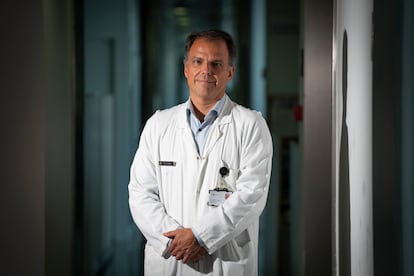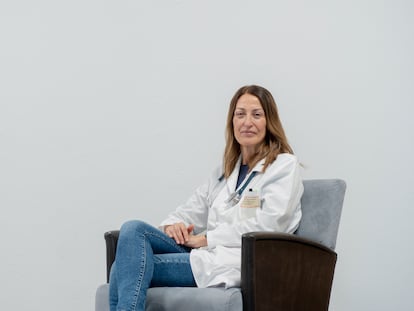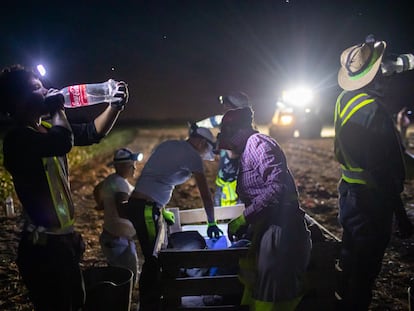‘Time is brain: The longer you take to go to the hospital after a stroke, the worse the damage’
Alberto Lleó, director of neurology at Sant Pau Hospital in Barcelona, warns that the rise in neurodegenerative diseases will continue to squeeze healthcare systems

To find out if the brain development of a newborn baby is normal, doctors usually look at – among other things – a small reflex action, triggered by exerting a tiny amount of pressure on the palm of the hand or the sole of the foot. This little movement in the first months of life provides invaluable information.
Lluís Barraquer Roviralta – considered the father of neurology in Spain – first utilized this technique over a century ago at Sant Pau Hospital in Barcelona. A full 140 years of scientific advances (and three generations of Barraquers) have now passed in the neurology clinics of Sant Pau. Today, specialized services in this area of medicine have taken giant leaps, thanks to the development of imaging technology.
“This is the decade of neurology,” proclaims Albert Lleó, the current director of the department that Barraquer created. The 50-year-old neurologist recently received a lot of media attention after his team successfully treated the 92-year-old former premier of Catalonia, Jordi Pujol, after he suffered a stroke. Pujol was released from hospital last weekend.
This interview has been translated and edited for clarity and brevity.
Question. How has the field of neurology changed in 140 years?
Answer. Neurological disorders are becoming more frequent. Many of these are age-related diseases – this is to be expected, given that people are living longer. It’s projected that the prevalence of degenerative diseases could triple within the next 30 years.
Q. How has the prognosis of these diseases evolved?
A. Thirty years ago, there were very few diseases that had effective treatment. In most cases, the causes and mechanisms were not well understood. For strokes, there were only antiaggregants, such as aspirin. Practically nothing was known about degenerative diseases. As for neuromuscular diseases, only cortisone or very broad-acting immunosuppressants were available. What has happened in recent years is that more knowledge about the causes has resulted in more effective treatments.
Q. It used to be said that neurologists know all about the diseases, but they can’t cure any of them…
A. This belief is totally obsolete. There are effective treatments for cerebral vascular diseases, for stopping blood clots from growing or causing problems… there are very effective treatments for migraines, there’s gene therapy treatment being carried out for spinal muscular atrophy. Perhaps the most difficult diseases to treat are Alzheimer’s and Parkinson’s.
Q. These are good times for neurology, then?
A. We are in a fantastic era, because of the therapeutic tools we have access to. But the rise of neurological diseases is also, in turn, a time bomb, because it can squeeze health services. We have aging populations, a greater prevalence of chronic diseases… all of this comes at a very high cost, the treatments aren’t cheap. This is why it’s very important to have adequate plans for Alzheimer’s, for example, or for other neurodegenerative diseases, to prioritize where we’re going to put the money – do we put it into long-term care homes or do we put it in research?
Q. Last week, former Catalan premier Jordi Pujol was proof that strokes can be reversible, even at an advanced age.
A. Today, more and more work is being done on biological age rather than on chronological age. That is, you can be 60 years old, but have the brain of an 80-year-old, because you’ve had an unhealthy lifestyle.
The rise of neurological diseases is a time bomb, because it can squeeze health services
Q. Mar Castellanos, the head of neurology at A Coruña Hospital, said in an interview with EL PAÍS that strokes don’t just take place among the elderly – more and more often, they are affecting the working age population. Why is this happening?
A. A stroke is highly influenced by lifestyle: smoking, diabetes, high cholesterol, a sedentary lifestyle, high stress levels… age is not the only factor.
Q. Speaking of lifestyle… even though we’re living longer, are we living worse? Are we harming our brain with our habits?
A. I think there is still a lack of awareness regarding the prevention and early detection of neurological diseases. In the case of a stroke, for example, there are people who still think that it’s not necessary to go to the emergency room, that you can wait and see if it goes away. We see this every day. And why is this happening? Because cardiovascular or cancer prevention campaigns began in the 1970s, but in neurology, they started much later – we’ve been repeating this message for less time. In the case of a stroke, time is brain: the longer it takes to get to the hospital, the more brain damage there will be. Neurological diseases have been largely neglected from the point of view of awareness campaigns and funding.
Q. There’s a kind of knowledge black hole when it comes to neurodegenerative diseases, which still have no treatment. Why?
A. Alzheimer’s, Parkinson’s… these are very difficult diseases to study and treat. Sometimes, many years may pass before a person notices the first symptoms. By the time they begin to notice and seek help, there is already significant brain damage. When someone has a tumor, oncologists do a biopsy of the tissue, analyze it and look for viable treatment options. But you can’t do a biopsy in the brain: we depend on imaging techniques, which don’t have microscopic resolution. We aren’t able to examine these diseases in detail in the early stages – not knowing what’s happening during these critical years makes it difficult to find treatments.
In Alzheimer’s, there are more than 50 genes involved – it’s very difficult to know what the sequence of events is. Even so, I would say that much progress has been made. And it’s also very clear that the greatest advances have been made in the degenerative diseases that have received the most funding, like Alzheimer’s and MS. The common thread of all chronic diseases – except for strokes – is to understand the immune system in our brain, about which very little is known. This will be essential research over the coming decades.
Q. How can the healthcare system remain sustainable?
A. It’s necessary to carry out a cost-effectiveness analysis. If we manage to reduce or postpone the onset of Alzheimer’s for five years with effective treatments, we can reduce the number of total cases and, most importantly, improve people’s quality of life. This has a very high cost, but maybe it will buy patients a few extra years of life outside of long-term care.
Tu suscripción se está usando en otro dispositivo
¿Quieres añadir otro usuario a tu suscripción?
Si continúas leyendo en este dispositivo, no se podrá leer en el otro.
FlechaTu suscripción se está usando en otro dispositivo y solo puedes acceder a EL PAÍS desde un dispositivo a la vez.
Si quieres compartir tu cuenta, cambia tu suscripción a la modalidad Premium, así podrás añadir otro usuario. Cada uno accederá con su propia cuenta de email, lo que os permitirá personalizar vuestra experiencia en EL PAÍS.
¿Tienes una suscripción de empresa? Accede aquí para contratar más cuentas.
En el caso de no saber quién está usando tu cuenta, te recomendamos cambiar tu contraseña aquí.
Si decides continuar compartiendo tu cuenta, este mensaje se mostrará en tu dispositivo y en el de la otra persona que está usando tu cuenta de forma indefinida, afectando a tu experiencia de lectura. Puedes consultar aquí los términos y condiciones de la suscripción digital.
More information
Últimas noticias
ICE raids trigger school absenteeism and traumatize children: ‘They have been forced to leave their childhood behind’
Mexico’s missing people crisis casts a shadow over World Cup venue
Can cheese protect brain health? This is what the science says
Maude Apatow, from acting in ‘Euphoria’ to directing: ‘There are many films that you can tell weren’t written by someone young’
Most viewed
- Christian Louboutin: ‘Young people don’t want to be like their parents. And if their parents wear sneakers, they’re going to look for something else’
- US sanctions against jailed cartel leader ‘El Marro’ highlight Mexico’s lack of control over its prisons
- Cartels in Mexico take a leap forward with narco-drones: ‘It is criminal groups that are leading the innovation race’
- Liset Menéndez de la Prida, neuroscientist: ‘It’s not normal to constantly seek pleasure; it’s important to be bored, to be calm’
- ‘El Limones’ and the growing union disguise of Mexican organized crime











































